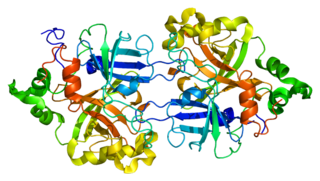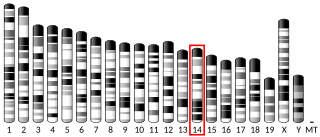
Complement factor B is a protein that in humans is encoded by the CFB gene.

Factor H (FH) is a member of the regulators of complement activation family and is a complement control protein. It is a large, soluble glycoprotein that circulates in human plasma. Its principal function is to regulate the alternative pathway of the complement system, ensuring that the complement system is directed towards pathogens or other dangerous material and does not damage host tissue. Factor H regulates complement activation on self cells and surfaces by possessing both cofactor activity for Factor I–mediated C3b cleavage, and decay accelerating activity against the alternative pathway C3-convertase, C3bBb. Factor H exerts its protective action on self cells and self surfaces but not on the surfaces of bacteria or viruses. There are however, important exceptions, such as for example the bacterial pathogen, Neisseria meningitidis. This human pathogen has evolved mechanisms to recruit human FH and down-regulate the alternative pathway. Binding of FH permits the bacteria to proliferate in the bloodstream and cause disease.

Complement C1q subcomponent subunit A is a protein that in humans is encoded by the C1QA gene.

C-C chemokine receptor type 10 is a protein that in humans is encoded by the CCR10 gene.
C-C motif chemokine 4-like is a protein that in humans is encoded by the CCL4L1 gene.

Galectin-10 is an enzyme that in humans is encoded by the CLC gene.

Ficolin-2, which was initially identified as L-ficolin, is a protein that in humans is encoded by the FCN2 gene.

Ficolin-3 is a protein that in humans is encoded by the FCN3 gene. Ficolin-3 was initially identified as H-ficolin, in which H is after the Hakata antigen that was previously found as an autoantigen in patients who lived in the city of Hakata.

Complement factor H-related protein 1 is a protein that in humans is encoded by the CFHR1 gene.

Ficolin-1, and also commonly termed M-ficolin is a protein that in humans is encoded by the FCN1 gene.

Progesterone-induced-blocking factor 1 is a protein that in humans is encoded by the PIBF1 gene. It has been shown to localize to the centrosome and has also been named CEP90.

Olfactory receptor 2H2 is a protein that in humans is encoded by the OR2H2 gene.

Complement C4-A is a kind of the Complement component 4 protein that in humans is encoded by the C4A gene.

39S ribosomal protein L28, mitochondrial is a protein that in humans is encoded by the MRPL28 gene.

Fc receptor-like A is a protein that in humans is encoded by the FCRLA gene.

Serine/threonine-protein kinase 19 is an enzyme that in humans is encoded by the STK19 gene.

Complement factor H-related protein 3 is a protein that in humans is encoded by the CFHR3 gene.

C-type lectin domain family 2 member D is a protein that in humans is encoded by the CLEC2D gene.

Complement factor H-related protein 5 is a protein that in humans is encoded by the CFHR5 gene.

Complement factor H-related protein 4 is a protein that in humans is encoded by the CFHR4 gene.
















